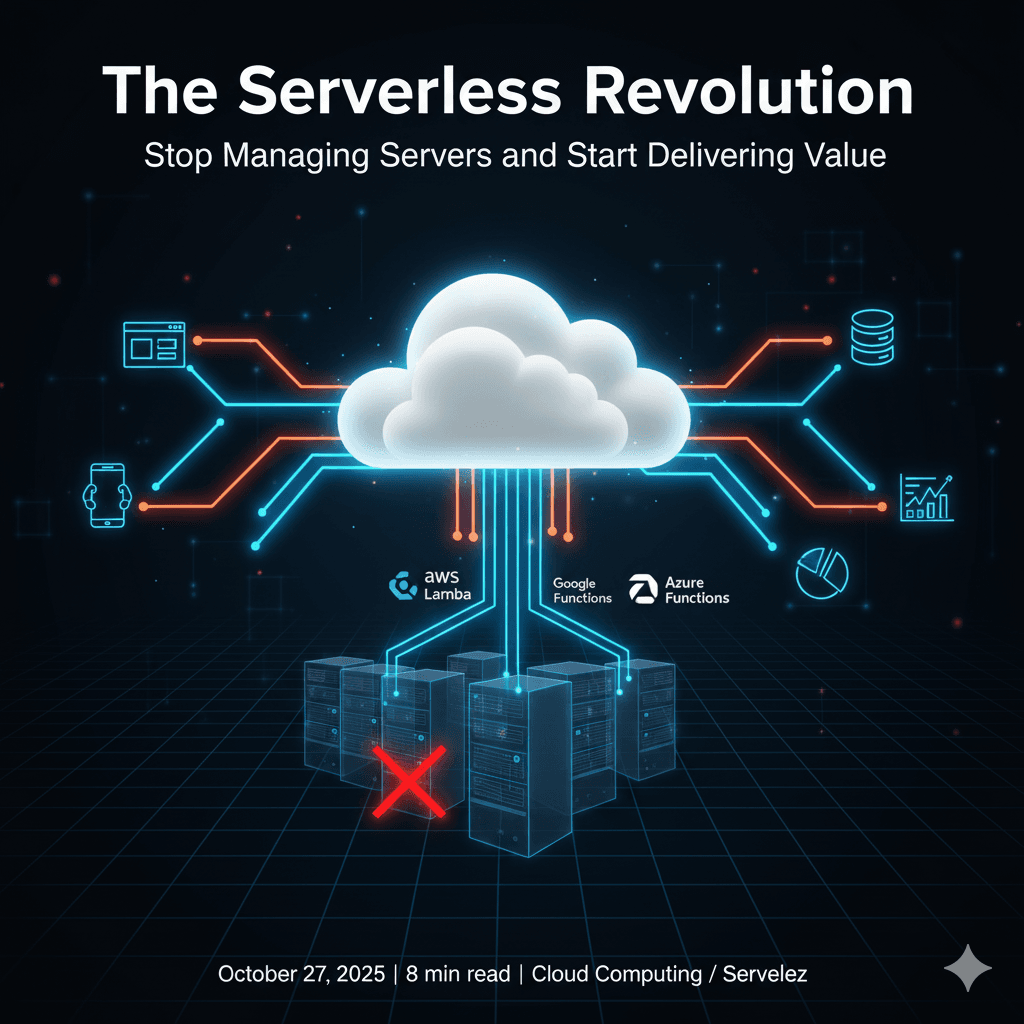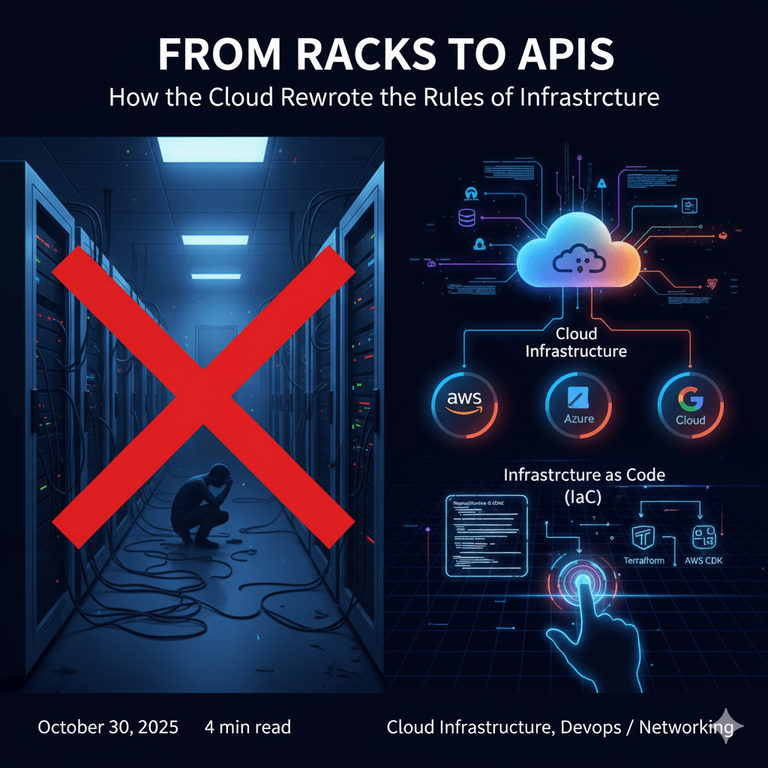The Serverless Revolution: Stop Managing Servers and Start Delivering Value
The days of paying for idle servers are over. Discover how serverless architecture from AWS, Google Cloud, and Azure lets you build infinitely scalable applications that only cost you when they run.

Imagine it’s 3 AM. An alert screams from your phone—your application has crashed. Why? A sudden traffic spike from a viral marketing campaign overwhelmed your carefully provisioned servers. You scramble to scale up, but by the time you do, the moment has passed, and you're left with frustrated users and an enormous bill for servers that are now sitting idle.
This is the classic infrastructure nightmare. For years, we've been trapped in a cycle of guessing capacity, overprovisioning "just in case," and paying for computing power 24/7, even when it's doing nothing.
Serverless computing is the end of that cycle.
It’s not about having no servers—it's about not managing them. What if you could treat computing like a utility, just like electricity? You don't own a power plant; you just plug in your device and pay for the kilowatts you use. Serverless applies this exact model to your code.
The Core Idea: From Servers to Functions
Serverless, or "Functions as a Service" (FaaS), fundamentally changes the deployment model. Instead of deploying a monolithic application onto a virtual machine, you deploy individual, stateless functions. Each function is a small piece of code designed to do one specific thing.
The magic happens in the execution:
- A Trigger Occurs: An event happens. This could be an HTTP request to an API endpoint, a new file being uploaded to a storage bucket, or a message appearing in a queue.
- The Cloud Provisions: The cloud provider instantly spins up a container, loads your function's code, and runs it.
- The Function Executes: Your code processes the event and returns a result.
- The Cloud Shuts Down: The container is shut down. You are billed only for the milliseconds your code was actually running.
If one request comes in, one function runs. If a million requests come in simultaneously, the cloud provider automatically runs your function a million times in parallel. This is infinite scalability with zero operational overhead.
The Big Three: AWS, Google Cloud, and Azure
While the concept is universal, each major cloud provider has a flagship serverless offering with unique strengths.
- AWS Lambda: The pioneer and market leader. Lambda's greatest strength is its deep, native integration with the entire AWS ecosystem. You can trigger a Lambda function from over 200 AWS services, from an S3 file upload to a DynamoDB table update.
- Google Cloud Functions: Tightly integrated with Google's ecosystem, especially Firebase and its powerful data analytics and ML services. It's an excellent choice for mobile backends and data processing pipelines.
- Azure Functions: Microsoft's offering shines with its developer-friendly approach, especially for those in the .NET world. Its unique "bindings" feature simplifies connecting to other services (like Azure Blob Storage or Cosmos DB) with declarative code instead of writing boilerplate SDKs.
Serverless in Action: A Simple API Endpoint with AWS Lambda
Let's see how simple this is. Here is a complete, production-ready serverless function using Node.js that acts as an API endpoint. This code would typically be deployed via a tool like the Serverless Framework or AWS SAM.
Code Example: handler.mjs (AWS Lambda Function)
// This is the entire 'backend' for a simple API endpoint.
// The 'handler' is the main function that Lambda will execute.
// The 'event' object contains all the request details (headers, body, etc.).
export const handler = async (event) => {
console.log('Received event:', JSON.stringify(event, null, 2));
// Extract the name from the query string, or default to 'World'
const name = event.queryStringParameters?.name || 'World';
// The business logic is simple: create a greeting message.
const message = `Hello, ${name}! The time is ${new Date().toISOString()}.`;
// The response must be in this specific format for API Gateway to understand.
const response = {
statusCode: 200, // HTTP success code
headers: {
'Content-Type': 'application/json',
},
body: JSON.stringify({
message: message,
}),
};
return response;
};When deployed, AWS provides a URL. Hitting https://<...>.amazonaws.com/dev/greet?name=Gemini would instantly run this code and return a JSON response—without a single server to provision, patch, or manage.
Where Serverless Shines: Real-World Use Cases
This model is incredibly powerful for a variety of applications:
- Lightweight APIs & Microservices: Create blazing-fast, highly scalable REST or GraphQL APIs without the cost of an always-on server. Perfect for mobile backends and webhooks.
- Real-Time File Processing: A user uploads an image to an S3 bucket. This triggers a Lambda function that automatically resizes it into thumbnails, adds a watermark, and updates a database.
- Data Processing Pipelines: Process streams of IoT data, analyze logs, or run ETL jobs in response to new data arriving in a message queue like SQS or Pub/Sub.
- Scheduled Tasks (Cron Jobs): Run a function on a schedule (e.g., every night at midnight) to generate reports, clean up a database, or run backups, paying only for the few seconds it takes to execute.
The Bottom Line: A Shift in Focus
Serverless architecture is more than just a technology; it's a mindset shift. It allows development and DevOps teams to stop worrying about infrastructure and focus exclusively on writing code that delivers business value. By abstracting away the complexity of scaling, redundancy, and maintenance, serverless empowers rapid innovation at a fraction of the traditional cost.
The promise is simple but profound: build better products, faster, and pay only for what you use. The serverless revolution is here.





